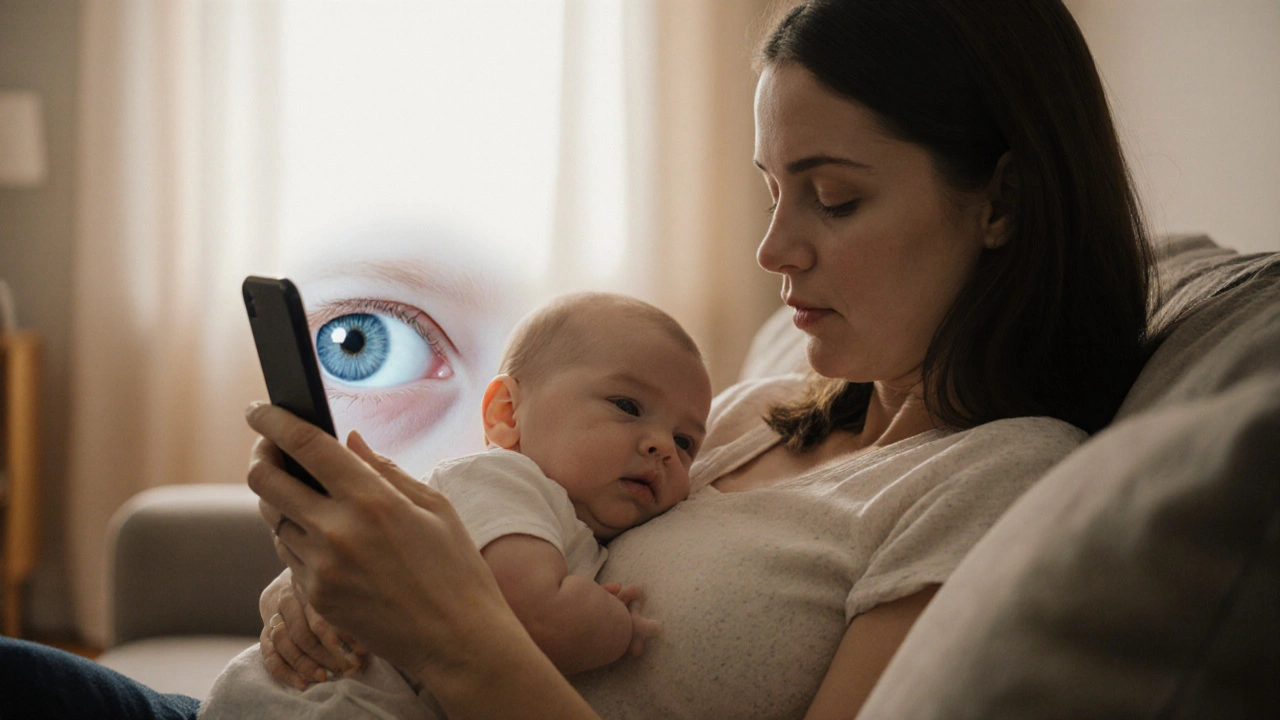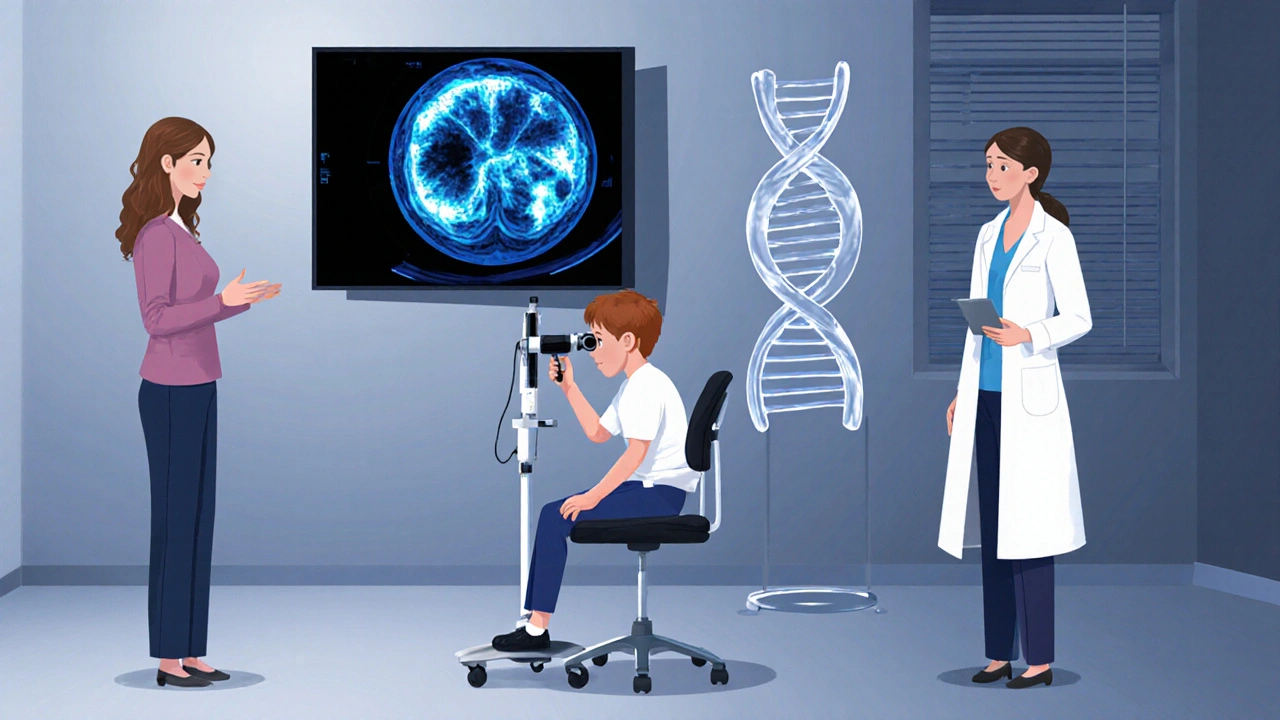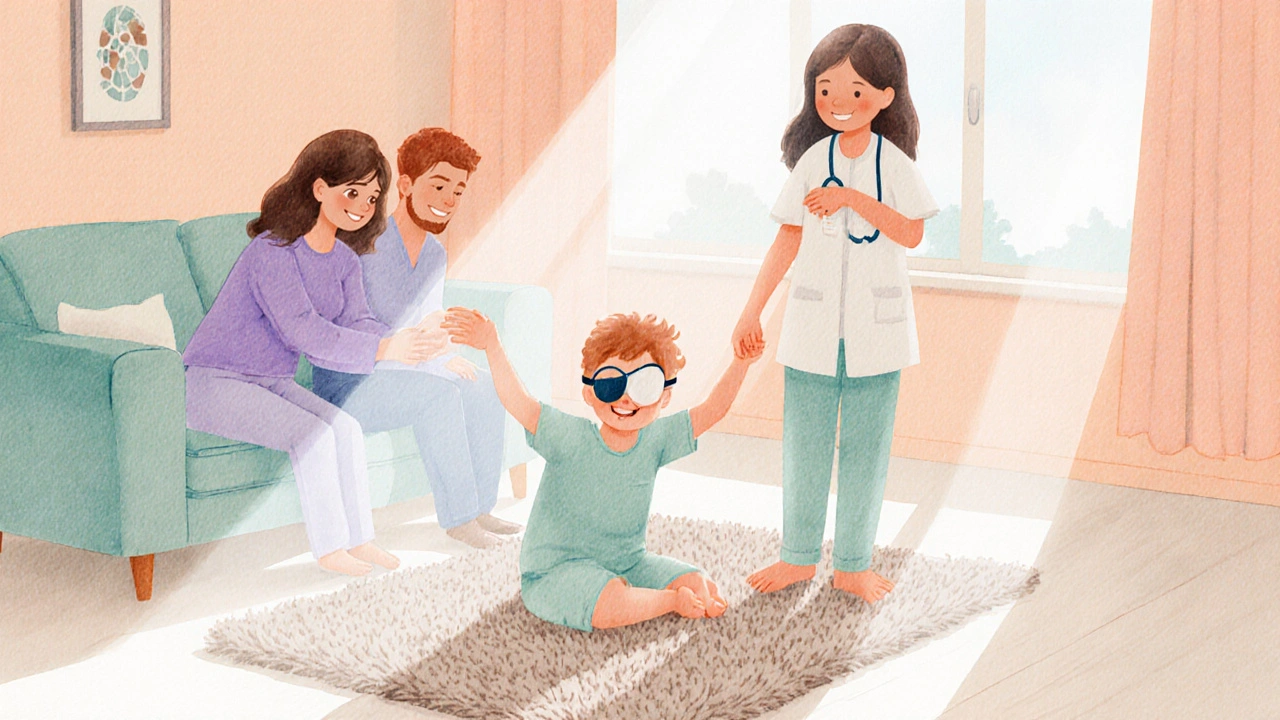Child Eye Cancer: Essential Guide for Parents
 Oct, 8 2025
Oct, 8 2025
Retinoblastoma Symptom Checker
Leukocoria
White or yellowish glow in the pupil, often seen in flash photos
Strabismus
Crossed or misaligned eyes that drift inward or outward
Eye Discharge
Unexplained eye discharge that doesn't clear with hygiene
Vision Problems
Reduced vision or difficulty tracking objects with one eye
Eye Pain
Redness, swelling, or pain in the eye
Flash Photos
Noticeable white reflex in photos taken with flash
Symptom Analysis
Key Takeaways
- Retinoblastoma accounts for about 95% of eye cancers in children.
- Early signs include a white glow in the pupil (leukocoria) and crossed eyes.
- Diagnosis relies on eye exams, imaging and genetic testing.
- Treatment ranges from laser therapy to eye removal, chosen based on tumor size and spread.
- Support services from the NHS and charities are crucial for families.
When a child receives a diagnosis of child eye cancer is a rare group of malignant tumors that develop inside the eye of infants and young children, most commonly retinoblastoma, the news can feel overwhelming. Understanding the disease, spotting symptoms early, and knowing the treatment pathway empower parents to make confident decisions for their little ones.
What Exactly Is Child Eye Cancer?
Child eye cancer is not a single disease; it describes any malignant growth that starts in the ocular structures of a child under ten years old. The overwhelming majority-about 95%-are retinoblastoma (a cancer that begins in the retina, the light‑sensing layer at the back of the eye. Fewer cases involve ocular melanoma or metastatic tumors that spread from other parts of the body.
Because the eye is a confined space, tumors can quickly impact vision, cause eye pain, or even force the eye to become disfigured if left untreated. Fortunately, most cases are caught early and have excellent survival rates when managed promptly.
Most Common Type: Retinoblastoma
Retinoblastoma can appear in two genetic forms:
- Hereditary (germline) form - caused by a mutation in the RB1 gene (a tumor‑suppressor gene that controls cell growth in the retina. Children inherit one faulty copy and are at risk of developing tumors in one or both eyes.
- Non‑hereditary (sporadic) form - a mutation occurs only in retinal cells, usually leading to a single‑eye tumor with no family history.
Both forms present with similar symptoms, but hereditary cases demand lifelong monitoring for secondary cancers.

Early Warning Signs Parents Should Watch For
Spotting the disease early dramatically improves treatment outcomes. Keep an eye out for these red flags:
- Leukocoria - a white or yellowish glow in the pupil, often noticed in photographs taken with a flash.
- Strabismus (crossed or misaligned eyes) - the affected eye may drift inward or outward.
- Redness or swelling of the eye, especially if it feels painful.
- Reduced vision or the child not tracking objects with one eye.
- Unexplained eye discharge that does not clear with basic hygiene.
If any of these appear, book an appointment with a pediatric ophthalmologist (a medical doctor specializing in eye diseases and surgery) right away.
How Diagnosis Works
Diagnosing child eye cancer involves several steps to confirm the tumor’s type, size, and spread:
- Clinical eye exam - using a handheld ophthalmoscope to visualize the retina.
- Imaging studies - ultrasound, MRI, and occasionally CT scans to map tumor dimensions.
- Genetic testing - a blood sample checked for RB1 gene mutations. Results guide family counseling and future screening plans.
- Systemic work‑up - chest X‑ray or bone scan if there’s suspicion of metastasis.
The entire process is usually coordinated by a multidisciplinary team that includes a pediatric ophthalmologist, a pediatric oncologist (a doctor who treats cancers in children with chemotherapy, radiation, or targeted therapy, and a genetic counselor.
Treatment Options: Choosing the Right Path
Therapy is tailored to the tumor’s size, location, and whether one or both eyes are involved. Below is a quick look at the most common approaches.
| Treatment | Invasiveness | Vision Preservation Rate | Typical Success Rate (5‑year survival) |
|---|---|---|---|
| Laser photocoagulation | Minimally invasive | High for small peripheral tumors | ~95% |
| Cryotherapy | Minimally invasive | High for tumors <5mm | ~95% |
| Systemic/Intravitreal chemotherapy (chemo drugs delivered through veins or directly into the eye | Moderate | Variable - better for larger tumors | ~98% |
| Enucleation | Highly invasive (eye removal) | None (eye is removed) | ~99% when tumor confined to one eye |
Beyond these, newer options like intra‑arterial chemotherapy (delivering drug directly via the eye’s blood supply) and targeted molecular agents are emerging, especially for bilateral disease.
Understanding child eye cancer early can make all the difference. If the tumor is small and detected before it spreads, less aggressive treatments often preserve vision and avoid the need for enucleation.

Living with the Diagnosis: Support & Practical Tips
Medical care is just one piece of the puzzle. Families also need emotional, logistical, and financial support:
- National Health Service (NHS) - provides free specialist appointments, surgery, and chemotherapy for children in the UK. Early referral to a tertiary eye‑cancer centre (e.g., Moorfields Eye Hospital) unlocks the full care pathway.
- Charities - organisations like Retinoblastoma UK (a support network offering information, counseling, and fundraising assistance) connect families with other parents who have walked the same road.
- Educational accommodations - talk to your child’s school about visual aids, preferential seating, and possible home‑learning options during intensive treatment phases.
- Genetic counseling - essential for families with hereditary RB1 mutations to understand risks for future children and to arrange appropriate screening.
Don’t underestimate the power of a daily routine: regular eye‑drops, scheduled follow‑ups, and a balanced diet rich in vitaminA can help maintain overall eye health.
Frequently Asked Questions
How common is eye cancer in children?
In the UK, retinoblastoma occurs in about 1 in 15,000 live births. While rare, early detection leads to survival rates above 95%.
Can a child lose vision completely?
If the tumor is detected before it affects the macula (central retina), many children retain usable vision. Enucleation is reserved for cases where the eye cannot be saved.
Is eye cancer hereditary?
About 40% of retinoblastoma cases are hereditary, linked to a germline RB1 mutation. Genetic testing clarifies the risk for siblings and future pregnancies.
What is the typical treatment timeline?
Initial assessment and imaging take 1‑2 weeks. Treatment, whether laser, chemotherapy, or surgery, usually spans 3‑6 months, followed by a surveillance phase lasting several years.
Are there long‑term side effects?
Potential effects include cataracts, secondary bone‑cancer (in hereditary cases), and cosmetic concerns after enucleation. Regular follow‑ups help manage these risks early.
Next Steps for Parents
If you suspect anything unusual, schedule an eye exam within 48hours. Keep a record of any photos that show a white pupil-these can be invaluable for the specialist.
After diagnosis, ask your care team for a written treatment plan that outlines:
- All recommended procedures and their timelines.
- Potential side effects and how they’ll be monitored.
- Contact information for a dedicated nurse or patient liaison.
Finally, lean on support networks; no parent should walk through this alone.

Katherine M
October 8, 2025 AT 17:09Thank you for assembling such a thorough overview of pediatric ocular oncology 😊. The concise symptom checklist is especially helpful for parents who might first notice a white reflex in photographs. Your explanation of hereditary versus sporadic retinoblastoma clarifies a common source of confusion. Moreover, the inclusion of NHS and charitable support resources reflects a holistic approach to care. I appreciate the balance between medical detail and empathy.
Bernard Leach
October 12, 2025 AT 04:29Indeed the information presented provides a solid foundation for families navigating this rare disease, the early detection of leukocoria can dramatically improve outcomes, the role of genetic testing cannot be overstated because it guides both treatment and family counseling, while the imaging modalities such as ultrasound and MRI offer non‑invasive ways to assess tumor size and spread, the multidisciplinary team approach ensures that pediatric oncologists, ophthalmologists and genetic counselors work in concert, the decision matrix between laser photocoagulation and enucleation depends heavily on tumor location and visual potential, parents should also be aware of the psychosocial impact of eye removal and the availability of prosthetic options, the survival rates for localized retinoblastoma exceed ninety‑five percent when treated promptly, however the long‑term surveillance for secondary malignancies remains essential for hereditary cases, dietary and environmental factors have not been shown to influence tumor genesis, nevertheless ongoing research into targeted molecular therapies offers hope for less invasive interventions, the emotional toll on families often leads to anxiety and guilt which can be mitigated by support groups, charities such as the Retinoblastoma Foundation provide financial assistance for travel and treatment costs, the importance of regular ophthalmic examinations cannot be overstated especially in children with a family history, schools and caregivers should be educated to recognize subtle signs like strabismus, the overall prognosis is favorable when the disease is caught early, finally a proactive stance on education and advocacy empowers parents to make informed decisions.
Shelby Larson
October 15, 2025 AT 15:49Honestly this guide hits the nail on the head – the symptoms are laid out so clear that even a busy parent can spot a problem fast. The bit about hereditary mutations is especially important because many families ignore the genetic risk definetely. However I have to say, the article could have stressed more how crucial it is to fight for quick appointments, the system can be slow and that delays cost vision. Overall it’s a solid resource but don’t just read it, act on it.
Mark Eaton
October 19, 2025 AT 03:09Spot on, Shelby! Your point about fighting for timely appointments is a great reminder – any hesitation can make a huge difference. Keep the energy up, and share this with anyone you know who might need a quick heads‑up. Together we can push for faster referrals.
Alfred Benton
October 22, 2025 AT 14:29While the article admirably outlines clinical pathways, it quietly sidesteps the unsettling reality that many healthcare institutions prioritize cost‑saving measures over early detection initiatives. The subtle omission of industry‑funded research bias suggests a deeper agenda that may compromise the transparency of treatment options. One must remain vigilant to the hidden influences that shape public health messaging, lest we accept a sanitized narrative that serves vested interests.
Susan Cobb
October 26, 2025 AT 01:49Alfred, your skepticism, though entertaining, overlooks the rigorous peer‑review standards that underpin the guidelines cited in this guide. The references to NHS resources and established oncology protocols demonstrate a commitment to evidence‑based practice rather than hidden agendas. Moreover, the very fact that this information is freely accessible counters any notion of corporate gatekeeping. While healthy doubt is valuable, in this case the data speaks louder than conspiratorial whispers.
Ivy Himnika
October 29, 2025 AT 12:09Thank you for this comprehensive resource 🧑⚕️. The structured breakdown of diagnostic steps aids both clinicians and families alike. I particularly appreciate the clear table comparing treatment modalities, as it demystifies complex decisions. Including emotional support avenues acknowledges the holistic needs of affected children. Well done on balancing technical depth with compassionate guidance.
Nicole Tillman
November 1, 2025 AT 23:29Ivy, your recognition of both medical and emotional aspects reflects a mature understanding of patient care. In confronting a diagnosis like retinoblastoma, families must navigate not only the clinical pathway but also the profound existential questions that arise. Balancing hope with realistic expectations can empower parents to make choices aligned with their values. Your emphasis on support services reminds us that healing transcends the purely physical realm.
Sue Holten
November 5, 2025 AT 10:49Great summary, straight to the point.
Tammie Foote
November 8, 2025 AT 22:09While brevity has its charm, a few extra details could help parents who are overwhelmed by medical jargon.
Jason Ring
November 12, 2025 AT 09:29Hey folks, just wanted to say this guide is pretty solid, but i think it could use a bit more on how to talk to kids about the whole thing without scarin them.
Kelly Hale
November 15, 2025 AT 20:49Listen up, Americans! We have the best hospitals and the most advanced research, yet we still see families struggling to get the care their children deserve, this is an outrage that we must address now, the government should allocate more funds to pediatric oncology because every child, regardless of where they live, deserves a fighting chance, our nation’s pride depends on how we treat the most vulnerable among us, let’s not forget the heroes-doctors, nurses, and researchers-who work tirelessly day and night, they deserve our unwavering support and resources, when we invest in cutting‑edge treatments like targeted gene therapy we not only save lives but also cement our global leadership in medical innovation, so I urge every citizen to push their representatives for increased funding, because the future of our children’s eyesight-and our national reputation-hangs in the balance.
Neviah Abrahams
November 19, 2025 AT 08:09This guide is useful but it glosses over the emotional trauma families endure it’s a harsh reality that statistics can’t capture.
Uju Okonkwo
November 22, 2025 AT 19:29Thank you for highlighting that, Neviah. It’s true that numbers alone don’t tell the whole story; the fear and uncertainty can be overwhelming for parents. Bringing in counseling services and peer support groups can make a huge difference in coping with the emotional load. I encourage families to reach out to local charities and online communities for both practical advice and moral support.